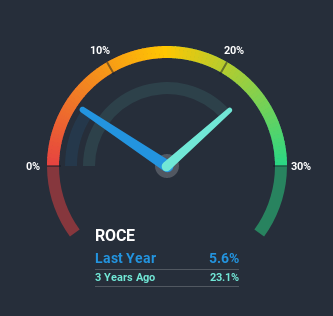Our Take On The Returns On Capital At Sumeeko Industries (GTSM:2066)

Did you know there are some financial metrics that can provide clues of a potential multi-bagger? Ideally, a business will show two trends; firstly a growing return on capital employed (ROCE) and secondly, an increasing amount of capital employed. Ultimately, this demonstrates that it's a business that is reinvesting profits at increasing rates of return. Although, when we looked at Sumeeko Industries (GTSM:2066), it didn't seem to tick all of these boxes.
Understanding Return On Capital Employed (ROCE)
Just to clarify if you're unsure, ROCE is a metric for evaluating how much pre-tax income (in percentage terms) a company earns on the capital invested in its business. To calculate this metric for Sumeeko Industries, this is the formula:
Return on Capital Employed = Earnings Before Interest and Tax (EBIT) ÷ (Total Assets - Current Liabilities)
0.056 = NT$93m ÷ (NT$2.6b - NT$926m) (Based on the trailing twelve months to September 2020).
Therefore, Sumeeko Industries has an ROCE of 5.6%. In absolute terms, that's a low return and it also under-performs the Machinery industry average of 9.3%.
View our latest analysis for Sumeeko Industries

While the past is not representative of the future, it can be helpful to know how a company has performed historically, which is why we have this chart above. If you want to delve into the historical earnings, revenue and cash flow of Sumeeko Industries, check out these free graphs here.
What The Trend Of ROCE Can Tell Us
In terms of Sumeeko Industries' historical ROCE movements, the trend isn't fantastic. Over the last five years, returns on capital have decreased to 5.6% from 26% five years ago. And considering revenue has dropped while employing more capital, we'd be cautious. If this were to continue, you might be looking at a company that is trying to reinvest for growth but is actually losing market share since sales haven't increased.
While on the subject, we noticed that the ratio of current liabilities to total assets has risen to 36%, which has impacted the ROCE. Without this increase, it's likely that ROCE would be even lower than 5.6%. While the ratio isn't currently too high, it's worth keeping an eye on this because if it gets particularly high, the business could then face some new elements of risk.
The Bottom Line
From the above analysis, we find it rather worrisome that returns on capital and sales for Sumeeko Industries have fallen, meanwhile the business is employing more capital than it was five years ago. Investors haven't taken kindly to these developments, since the stock has declined 40% from where it was five years ago. With underlying trends that aren't great in these areas, we'd consider looking elsewhere.
Sumeeko Industries does have some risks, we noticed 5 warning signs (and 2 which are concerning) we think you should know about.
While Sumeeko Industries isn't earning the highest return, check out this free list of companies that are earning high returns on equity with solid balance sheets.
If you’re looking to trade Sumeeko Industries, open an account with the lowest-cost* platform trusted by professionals, Interactive Brokers. Their clients from over 200 countries and territories trade stocks, options, futures, forex, bonds and funds worldwide from a single integrated account. Promoted
New: Manage All Your Stock Portfolios in One Place
We've created the ultimate portfolio companion for stock investors, and it's free.
• Connect an unlimited number of Portfolios and see your total in one currency
• Be alerted to new Warning Signs or Risks via email or mobile
• Track the Fair Value of your stocks
This article by Simply Wall St is general in nature. It does not constitute a recommendation to buy or sell any stock, and does not take account of your objectives, or your financial situation. We aim to bring you long-term focused analysis driven by fundamental data. Note that our analysis may not factor in the latest price-sensitive company announcements or qualitative material. Simply Wall St has no position in any stocks mentioned.
*Interactive Brokers Rated Lowest Cost Broker by StockBrokers.com Annual Online Review 2020
Have feedback on this article? Concerned about the content? Get in touch with us directly. Alternatively, email editorial-team (at) simplywallst.com.
About TPEX:2066
Flawless balance sheet with questionable track record.
Market Insights
Community Narratives



